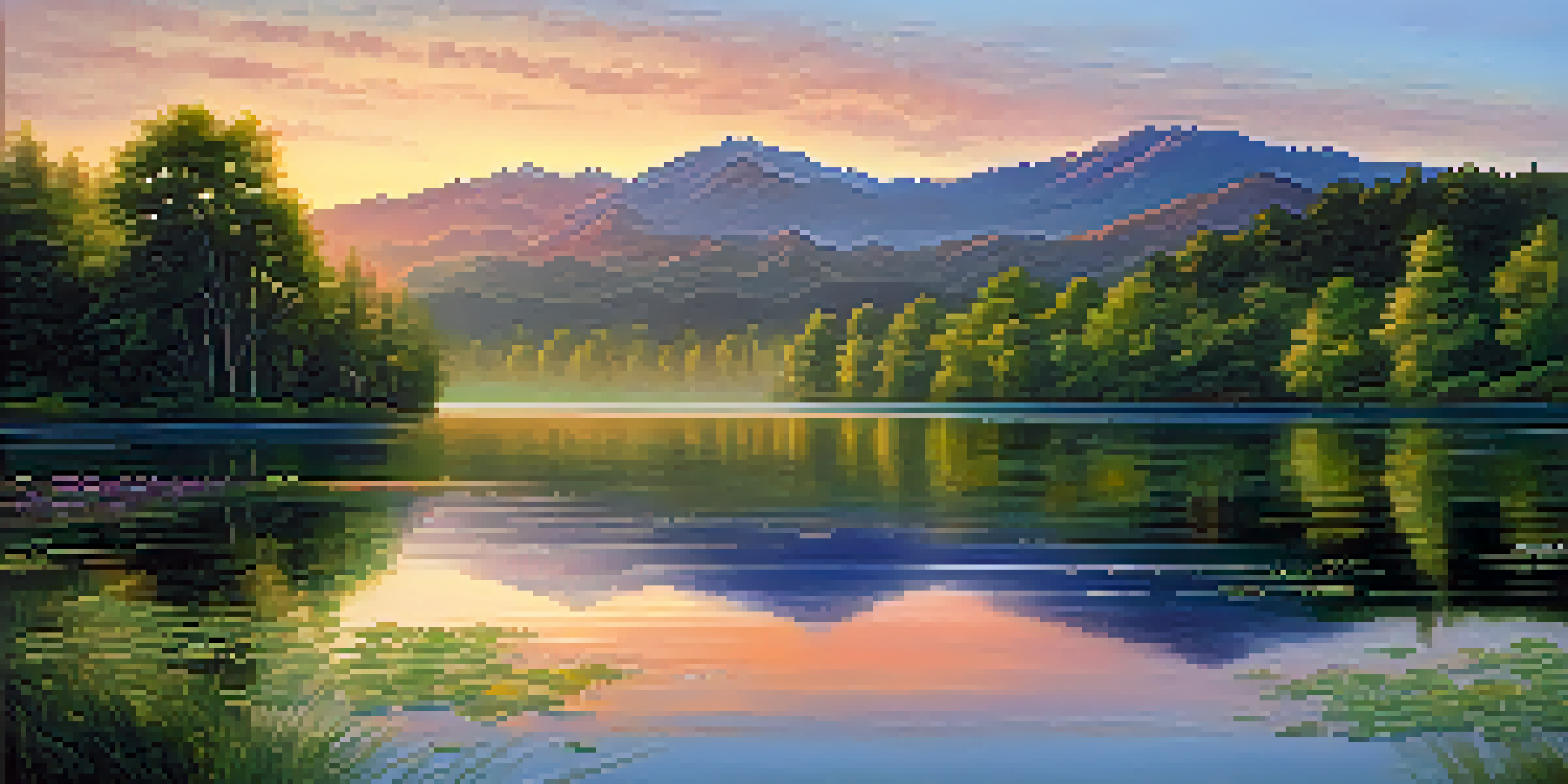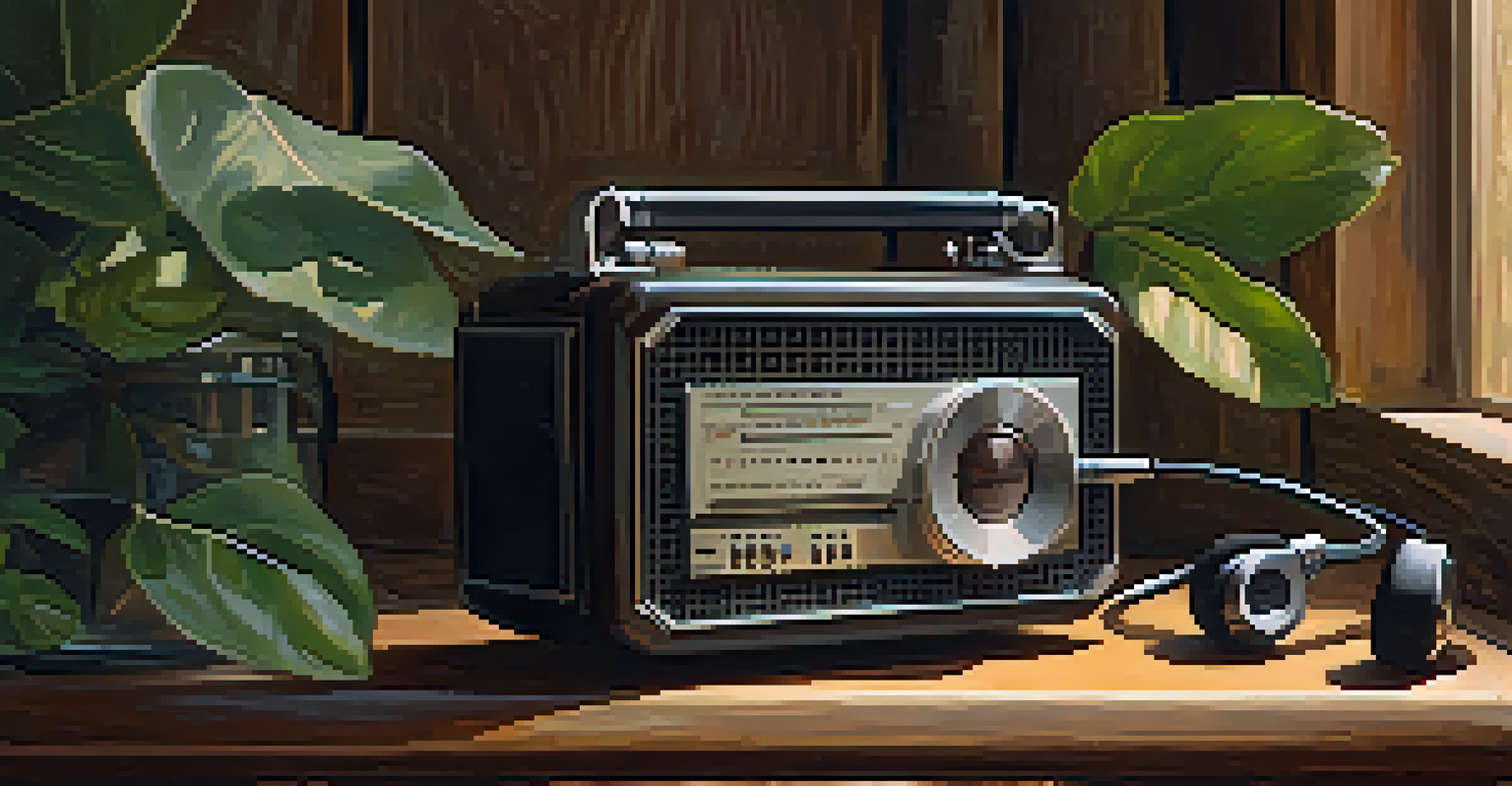Creating Unique Soundscapes: The Power of Field Recordings

Understanding Field Recordings and Their Importance
Field recordings are audio captures of sounds from our environment, ranging from bustling city streets to serene nature settings. They serve as a valuable tool for artists, musicians, and sound designers, providing a rich tapestry of auditory experiences. By recording the world around us, we can preserve moments in time, creating a library of sounds that reflect the essence of a particular place.
Sound is the vocabulary of nature.
These recordings can transport listeners, evoking emotions and memories tied to specific locations. Imagine the soothing sound of waves lapping at a shore or the vibrant chatter of a local market; each sound tells a story. Field recordings not only enrich artistic projects but also help us appreciate the unique sound profiles of different environments.
In a world where digital sounds dominate, field recordings offer a refreshing contrast. They remind us of the organic textures and rhythms present in our surroundings, encouraging us to slow down and listen. This connection to the real world can inspire creativity and deepen our understanding of sound as an art form.
The Process of Capturing Field Recordings
Capturing field recordings is both an art and a science, starting with the right equipment. A good quality portable recorder and microphones are essential for accurately capturing sounds. Depending on what you're recording, you may choose different types of microphones, such as shotgun mics for directional sound or contact mics for vibrations.

Finding the perfect location is just as critical as having the right gear. Consider the time of day and weather conditions, as they can dramatically affect the quality of your recordings. Early mornings or late afternoons often yield softer, more pleasant sounds, while bustling daytime recordings can capture the vibrant energy of a location.
Field Recordings Capture Real Sounds
Field recordings are vital for preserving and sharing the unique auditory experiences of various environments.
Once you're set up, it’s all about patience and observation. Listen carefully before hitting record; the best sounds often emerge when you least expect them. Allow yourself to get lost in the moment, and don’t be afraid to experiment. Sometimes, the most unique recordings come from unexpected sources or angles.
Editing and Enhancing Field Recordings
After capturing your field recordings, the editing process begins. This is your chance to refine and enhance the audio, ensuring it aligns with your creative vision. Basic editing software can help you trim unwanted noise, adjust levels, and even add effects that enhance the sound without losing its authenticity.
The beauty of sound is that it can create memories and feelings that are often lost in visual art.
One common technique is to layer multiple recordings to create a richer soundscape. For instance, combining the sound of wind rustling through trees with distant birdsong can evoke a peaceful forest ambiance. This layering can transform simple recordings into complex auditory experiences that captivate listeners.
However, it's essential to strike a balance between enhancement and authenticity. Over-editing can strip recordings of their natural essence, making them feel artificial. Aim to preserve the unique characteristics of each sound while enhancing its clarity and impact—a fine line that takes practice to master.
Incorporating Field Recordings into Creative Projects
Field recordings can be a powerful addition to various creative projects, from music and film to sound installations and podcasts. Musicians often use these recordings to add depth and texture to their compositions, blending organic sounds with digital elements. This fusion creates a unique auditory palette that resonates with audiences on a deeper level.
In film and theater, field recordings can help set the scene and evoke emotions. The sound of rain gently falling or distant thunder can instantly transport viewers, enhancing the narrative experience. Sound designers frequently rely on these recordings to create immersive environments that draw audiences into the story.
Editing Enhances Authentic Sound
The editing process allows creators to refine field recordings while maintaining their natural essence.
Podcasts and audio storytelling can also benefit from the inclusion of field recordings. Incorporating real-world sounds can enrich the listener's experience, making stories more relatable and engaging. By weaving these recordings into your narratives, you can create a sonic landscape that complements and enhances your message.
The Role of Technology in Field Recordings
Advancements in technology have significantly transformed the field of sound recording. High-quality portable recorders and mobile apps have made it easier than ever for anyone to capture sounds on the go. This accessibility encourages more people to explore field recordings, expanding the range of sounds and stories available.
Moreover, software and apps now enable easier editing and sharing of recordings. Cloud storage and social media platforms allow creators to showcase their work and collaborate with others, fostering a community of sound enthusiasts. These technological advancements have democratized sound recording, making it a more inclusive practice.
However, while technology plays a crucial role, it’s essential to remember the artistry involved in field recordings. The human touch—the choice of location, the moments of spontaneity—remains irreplaceable. Balancing technology with personal creativity can lead to truly unique soundscapes.
Exploring the Emotional Impact of Soundscapes
Soundscapes have a profound emotional impact on listeners, often evoking memories and feelings tied to specific experiences. For example, the sound of a crackling fire may remind someone of cozy nights spent with family. This connection between sound and emotion is a powerful tool for artists and creators.
Incorporating field recordings into projects can deepen this emotional resonance. By capturing sounds that reflect personal experiences or cultural backgrounds, creators can forge stronger connections with their audience. Each sound carries a story, and sharing these narratives through audio can foster empathy and understanding.
Technology Expands Recording Access
Advancements in technology have made field recording more accessible, encouraging creativity and collaboration among sound enthusiasts.
Furthermore, soundscapes can influence mood and atmosphere. Calm nature sounds can create a peaceful environment, while urban sounds may evoke energy and excitement. By thoughtfully selecting and arranging field recordings, creators can guide listeners through an emotional journey, enhancing their overall experience.
The Future of Field Recordings in Art and Media
As the world becomes increasingly digital, the future of field recordings looks promising. Artists and creators are continually finding innovative ways to incorporate these recordings into their work, pushing the boundaries of sound and art. This evolution reflects a growing appreciation for the unique qualities of real-world sounds and their ability to enrich our experiences.
Emerging technologies, such as virtual reality (VR) and augmented reality (AR), are also opening new avenues for field recordings. Imagine stepping into a virtual world where you can hear the sounds of a bustling market or the tranquility of a forest, enhancing the immersive experience. This integration of sound with technology could redefine how we interact with art and storytelling.

Ultimately, the field recording movement encourages us to stay attuned to our surroundings. As we continue to explore and create with these unique sounds, we foster a deeper connection to the world around us. The future of soundscapes is bright, and it invites us all to listen more closely and embrace the beauty of our auditory environment.